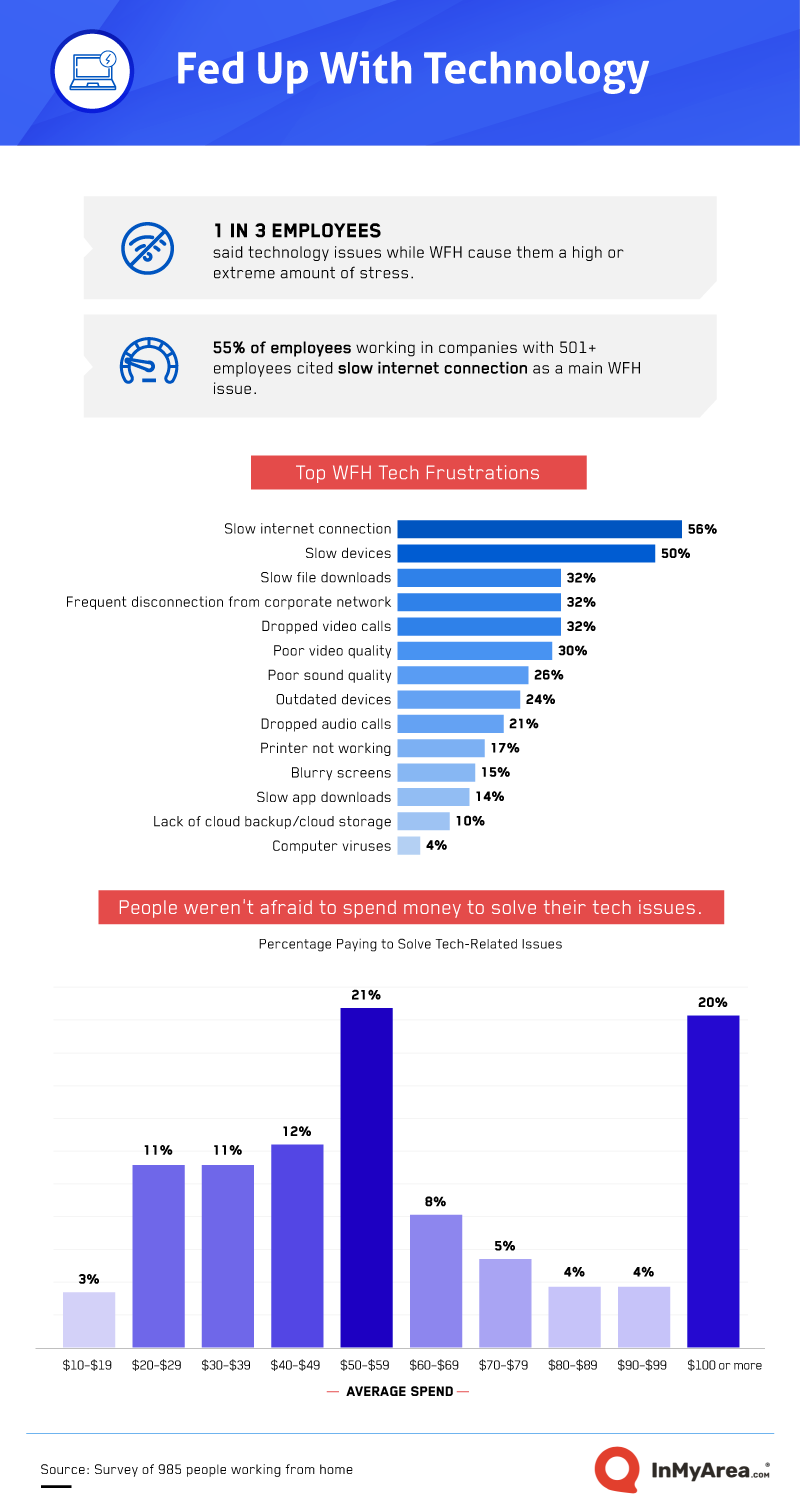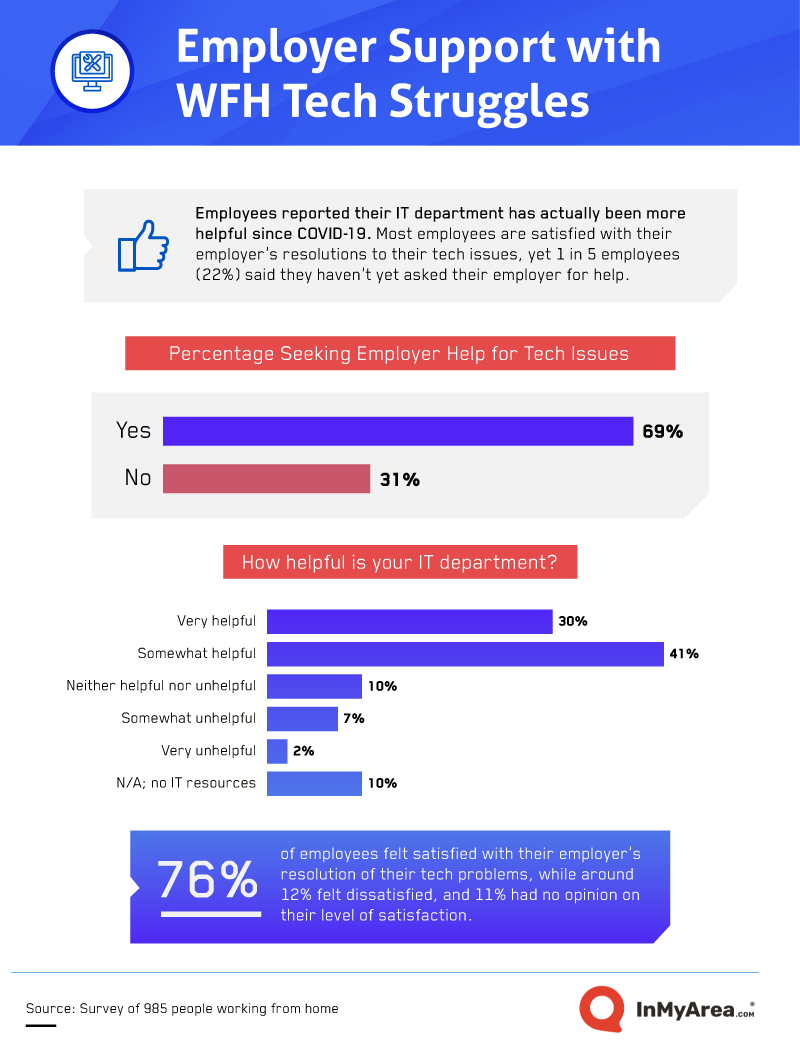Computer troubles are frustrating enough, even when you’re simply trying to watch a TV show or play a game. But when you’re working, trying to meet deadlines, or coordinating with co-workers, the stress of tech issues can reach entirely new heights. Especially among today’s newly remote workforce, tech issues during work hours are incredibly common.
With 58% of American employees now working remotely, we wanted to know how tech issues at home are impacting the country’s workforce. How commonly do tech issues arise? How are they being resolved? And how are important factors like productivity, job satisfaction, and general motivation correlated with technological struggles? We recently surveyed nearly 1,000 people who all work from home to find out. Keep scrolling to read what they had to share.
Most Common Remote Technology Issues
Our study begins with a look into the most common issues remote workers face today with regards to technology. We also looked at the methods of addressing these issues, as well as the financial costs incurred.

More than half of all remote employees reported experiencing some type of tech issue, but 1 in 3 said these issues cause them a high or even extreme amount of stress. Extreme stress is known to seriously impair workplace productivity, not to mention contribute to health issues, like heart disease and mental disorders.
The most common source of tech-stress for most was a lack of speed: slow internet connections (56%), slow devices (50%), and slow file downloads (32%). That said, the most stressful problems were things like viruses and backup options, which fortunately were experienced by a smaller percentage of employees. Additional stress likely stemmed from the fact that these issues aren’t always free to fix nor covered by employers. Instead, 47% of employees had spent their own dime resolving their tech problems. Remote workers are thought to save an average of $4,000 a year on avoiding commuting costs, yet 20% of workers told us they had spent $100 or more on resolving a single tech issue. Fewer than 3% had spent no money at all fixing these types of problems. Unfortunately, financial strain can increase the stress already existing from the original tech problem.
Relying on IT While Remote
With so many remote employees experiencing frustrating and costly tech problems, we next turned our study to focus on IT departments. Are employees using their services in these problematic moments? And is the IT department helpful when contacted?

Since COVID-19, most employees reported their IT department as becoming increasingly helpful. When contacted, the IT team was found to be either somewhat or very helpful; however, 31% of employees still didn’t reach out for help, even when experiencing a tech problem. And 1 in 5 hadn’t asked their employer for help in any way.
Moral of the story? When people are proactive in reaching out for help, their efforts typically pay off. Instead of spending your own money and enduring unnecessary workplace stress, reach out for help when you need it. Especially when it’s a matter of getting the job done.
Support’s Impact on Productivity, Satisfaction, and Motivation
IT support evidently extends well beyond the technological issue at hand. The last part of our study looked at the impact tech support could have on workplace productivity, job satisfaction, and motivation among remote employees.
- Across all company sizes, the majority of employees were satisfied with their employer’s IT help.
- 80% of people working in companies with 501+ employees reported satisfaction with their employer’s IT help.
- The highest percentage of employees satisfied with their employer’s IT help (83%) were found in companies with between 51 and 100 employees.

If an IT issue was resolved poorly, it took an enormous toll on job satisfaction. On the bright side, this meant that successfully resolving an IT issue could be the answer to overall job satisfaction. Fifty-five percent of employees who received satisfactory help described themselves as satisfied with their job as a whole. Less than 19% of employees who were dissatisfied with their employer’s IT support could say the same.
While job satisfaction saw the largest improvement with satisfactory IT help, productivity and motivation were helped as well. Those who felt satisfied with their employer’s ability to resolve IT issues experienced improvements in both workplace productivity and their levels of motivation. Motivation both in and out of the workplace can become extremely problematic for many in the midst of a pandemic, which places increasing importance on resolving frustrating tech problems as effectively as possible.
Our Data
We surveyed 985 people about their WFH technology experiences. Fifty-two percent of respondents were men, and 48% were women. Respondents ranged in age from 18 to 88 with an average age of 38 and a standard deviation of 11.
For short, open-ended questions, outliers were removed. To help ensure that all respondents took our survey seriously, they were required to identify and correctly answer an attention-check question.
Much of this study relies on self-reported data, which carry inherent issues, such as exaggeration and recency bias.

